#carcharocles
Text


Carcharocles auriculatus tooth
51 notes
·
View notes
Text

A worn fossilized shark tooth of an Otodus sokolovi from the Samlat Formation in Dakhla, Morocco. This lesser known species of Otodus is sometimes synonomized with Otodus auriculatus, and represents a transitional form between it and Otodus angustidens.
#fish#shark#chondrichthyan#fossils#paleontology#palaeontology#paleo#palaeo#otodus#carcharocles#eocene#cenozoic#prehistoric#science#paleoblr#オトドゥス#カルカロクレス#オトドゥス科#サメ#化石#古生物学
9 notes
·
View notes
Photo

Ancient Elasmobranchii
#carcharocles megalodon#megalodon#ctenacanthus amblyxiphias#ctenacanthus#falcactus falcactus#falcactus#Stethacanthus altonensis#Stethacanthus#Ironing-Board Shark#aquilolamma milarcae#eagle shark#orthacanthus#paleoart#ancient sharks#prehistoric#prehistoric art#shark#sharks#my art#q
134 notes
·
View notes
Text

And now, to meet our contestants:
Two famous beasts, on one side we have the current biggest non filter feeding shark and on the other we have the biggest shark to ever live (that we know of).
Some facts.
Great White (Carcharodon carcharias): the great white can reach up to around 5,8m (19.1 feet), besides being the greatest fear for people on the beach, they're pretty harmless to humans, we're not a 5* course meal and they usually attack when they confuse us with a seal. Their eyesight is horrible. As any animal, it can also attack if it feels threatened.
Megalodon (Carcharocles megalodon): it lived during the miocene and pliocene around 23 to 3,6 millions ago. Megalodon is from a line of giant sharks, presumably from the Otodontidae family. With the lack of bones and only teeth, its hard to really estimate it's size but it could've reached 20 meters (67ft).
48 notes
·
View notes
Note
Kind of out there idea but prehistoric au for Lemon? Perhaps it's one of Lemon's verrrrrrrrry distant ancestors so think the megalodon and she's captured by prehistoric man for food but they find she's quite the horny little Carcharocle~
8 foot tall Lemon....
She's captured and bound but they caught her during the mating season, so she's in crazy heat when she gets tot he surface. Instead of killing and eating her, the entire community takes turns fucking her and taking care of her massive belly as she gets bigger with their children
4 notes
·
View notes
Text
Traduction du français vers l'espagnol de l'article Le mégalodon, plus grand prédateur marin connu, n’a finalement pas ressemblé au requin blanc, selon une étude du journal Libération
Página principal/Ciencias/Arqueología
Ciencias
Al final, el megalodón, el mayor depredador marino conocido, no pareciéndose al jaquetón blanco, según un estudio
El debate queda abierto entre los investigadores a propósito de su aspecto y tamaño, estimados entre 15 y 20 metros de longitud. Un estudio publicado el lunes 22 de enero le atribuye el aspecto de un tiburón mako y no de un jaquetón blanco.
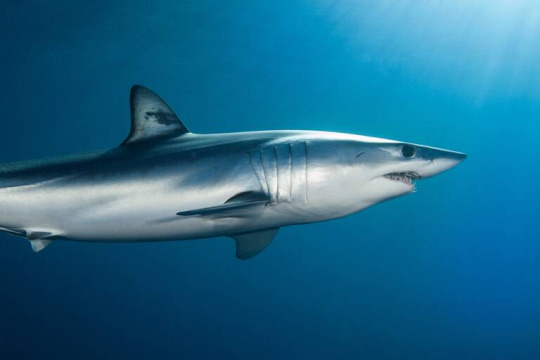
El megalodón se habría parecido más a un marrajo que a un tiburón blanco. (Richard Robinson/Cultura Creative. AFP)
por Sascha Garcia y AFP
publicado el 22 de enero de 2024 a las 11h37
Un temible depredador marino con grandes dientes y un lado impresionante… Pero quizá no tan grande como se imaginaba. Un estudio, publicado este lunes 22 de enero en la revista Palaeontologia Electronica, describe al megalodón, una de las mayores criaturas marinas que han existido, como más delgado de lo que se había representado hasta ahora.
El megalodón, cuyo nombre científico es Carcharocles megalodon, desapareció de los océanos hace 3,6 millones de años, y muchos investigadores siguen intentando reconstruir su aspecto y tamaño, estimado entre 15 y 20 metros de longitud, a partir de los escasos restos disponibles. Este margen de error se explica por el escaso número de fósiles que quedan, dientes incompletos y conjuntos de vértebras.
Similar al tiburón Mako
“Nuestro equipo reexaminó el registro fósil y descubrió que el Megalodón era mucho más delgado”, de lo que se pensaba, dijo el biólogo Phillip Sternes, de la Universidad de California en Riverside, en un comunicado. “No obstante, habría sido un depredador asombroso, en la cima de la cadena alimentaria marina”, añadió el autor principal del estudio. En lugar del impresionante lado del jaquetón blanco, el animal habría tenido el aspecto del actual tiburón mako, mucho más esbelto. Basándose en este nuevo análisis, los investigadores le atribuyen un comportamiento muy específico. No habría necesitado cazar muy a menudo debido a su larguísimo tracto digestivo, acorde con su gran tamaño.
Este aspecto también podría haber resultado una desventaja cuando llegaron depredadores más fornidos, pero también más rápidos que él. Según Kenshu Shimada, paleo-biólogo de la Universidad DePaul de Chicago y coautor del estudio, el megalodón “podría no haber sido un nadador potente” en comparación con el jaquetón blanco. Aunque una de las teorías que explican la extinción del megalodón se basa en la escasez de sus presas, ahora los investigadores estadounidenses plantean otra hipótesis. “Una combinación de factores llevó a su extinción, pero uno de ellos pudo ser la aparición del jaquetón blanco, que quizá era más ágil y, por tanto, mejor depredador que el Megalodón”, explica Phillip Sternes.
En última instancia, para tener una representación exacta de la verdadera forma de este animal, habría que hacerse con un esqueleto más completo que los escasos elementos de que disponen los paleontólogos. Kenshu Shimada es más poético: “El hecho de que no sepamos exactamente cómo era el Carcharocles megalodon da rienda suelta a la imaginación.” Cada uno puede imaginar cómo podría haber sido este terrorífico monstruo marino.
Referencia:
ES · ¡Hola a todos! La traducción de esta semana se refiere a un artículo sobre la posible forma del megalodón, un animal que me fascina y me aterroriza…
¡Disfruten de la lectura!
FR · Bonjour tout le monde ! La traduction de cette semaine porte sur un article consacré à la potentielle forme qu'avait le mégalodon, un animal qui me fascine et me terrifie à la fois…
Bonne lecture !
1 note
·
View note
Text
#171
Charocle

(Art by @the-cutest-motherfucker-ever )
Water
Close-Range
Large
Lp: High
Atk: Excellent
Def: Average
Acc: High
Spd: Average
Support: Ally -20% Atk, -20% Def, -20% Acc, -20% Spd
With high stats and scare skills balanced out by its detrimental support effects, Charocles is a powerful presence on the battlefield, for better or worse.
-
Carcharocles
45 feet
Paleozoic Paleocene - Cenozoic Neogene
Diet: Carnivore
Location: Worldwide
Also known as Otodus, this genus includes the infamous Megalodon among its ranks.
-
Charocle is found in curious fossil rocks. It has a super evolver.
Thanks to @mojojax2500 and @the-cutest-motherfucker-ever for helping with the design, idea, and art of this vivosaur.
#fossil fighters#fossil fighters revival#vivosaurs#original vivosaurs#fanmade vivosaurs#carcharocles#megalodon#water vivosaurs#curious fossil rocks
8 notes
·
View notes
Photo
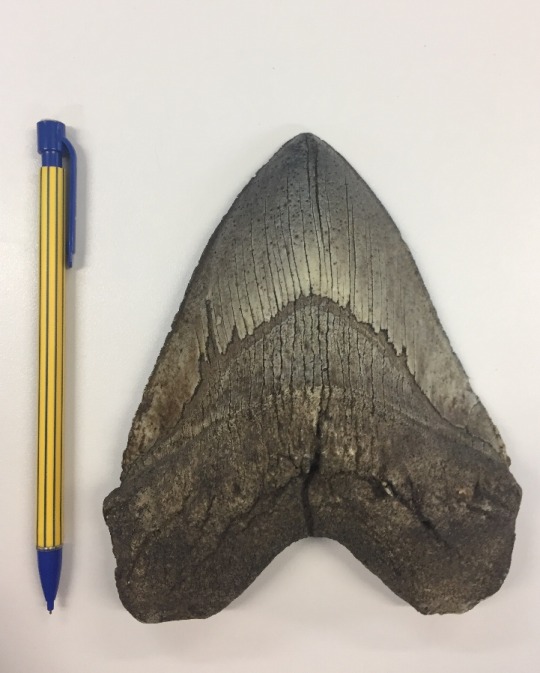
Carcharocles/Otodus megalodon tooth
#shark#megalodon#fossil#cenozoic#miocene#pliocene#otodus#carcharocles#paleontology#palaeontology#geology
34 notes
·
View notes
Photo
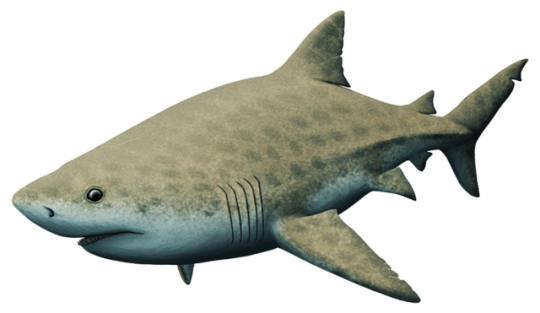
Almost-Living Fossils Month #27 -- Those Giant Sharks
For the final entry this month, let’s look at a particularly famous lineage: the megatooth sharks.
More formally known as the otodontids, the megatooths were a group of sharks that first appeared in the Early Cretaceous, about 115 million years ago. They were a branch of the mackerel shark lineage -- making them evolutionary cousins to a variety of modern species like the great white shark, basking shark, and goblin shark -- and had a near-worldwide distribution, with fossils known from every continent except Antarctica.
Early otodontids in the Cretaceous were usually small-to-medium sized, around 2-3m long (6′6″-9′10″), but after surviving through the end-Cretaceous extinction they took over the marine apex predator niches left vacant by the vanished mosasaurs and plesiosaurs and began to get very big. Species of Otodus in the Paleocene and early Eocene may have reached sizes of at least 9m long (29′6″), twice the size of an average great white.
Their teeth gradually became proportionally larger in their jaws, losing their side cusplets and taking on a chunky triangular shape with finely serrated edges. This gave them an incredibly powerful bite force, and they would have probably fed on pretty much any other large marine vertebrates they could catch, including bony fish, smaller sharks, turtles, and early penguins -- and then when marine mammals like early whales and sirenians appeared in the mid-Eocene, they adapted to this new food source too.
By the Late Eocene (~35 mya) the Otudus lineage was still developing even chunkier and more serrated teeth, and by the Early Oligocene (~28 mya) Otodus chubutensis reached even larger sizes rivaling the modern whale shark at around 12m long (39′4″).
But the most well-known member of the group evolved just a few million years later in the Early Miocene (~23 mya) – the absolutely enormous "megalodon".
There’s some debate about what genus name megalodon should be assigned to – at the moment its formal name is usually considered to be Otodus megalodon, but some paleontologists place it in Carcharocles or Megaselachus or Procarcharodon instead. Whatever you want to call it, it was a ridiculously big shark – size estimates range up to about 18m (59′), which would make it potentially the largest fish to have ever lived.
Since these huge sharks are all known mostly from just their fossilized teeth (and occasionally a few exceptionally preserved cartilaginous vertebrae), it’s hard to tell what they actually would have looked like in life. Megalodon is frequently depicted as simply a scaled-up great white, but it’s unclear how accurate that really is -- it may have convergently resembled a giant great white due to their similar predatory habits, or it could have had a build more like the larger basking shark or whale shark.
A preserved megalodon skull has actually been found, but no studies of it have been published yet. It might give us some important clues about the head shape of this giant shark, but until there’s some official information all we can do is continue to speculate.
Megalodon was a highly successful species, living all around the world in warm and temperate ocean waters for around 20 million years. Its teeth have been found in association with the bones of many different smaller whale species, suggesting it frequently ate marine mammals, and the patterns of the bites marks indicate it probably used different hunting strategies than modern great whites. Some whales seem to have been heavily rammed and then had their ribcages bitten into, targeting their hearts and lungs, while others had their flippers ripped off to immobilize them.
During the Pliocene (~5-2.6 mya), however, megalodon began to struggle. Cooling oceans and changes in the abundance of the marine mammals it ate began to restrict its available prey. Baleen whales started to grow too large for it to effectively hunt, since it preferred to target smaller species, and they also shifted their ranges towards the cold polar waters that megalodon didn’t seem to be able to survive in. In addition, dropping sea levels may have destroyed most of its shallow warm-water nursery sites, making it harder for newborn young to survive into adulthood.
By the end of the Pliocene, somewhere between 3.6 and 2.6 million years ago, megalodon went completely extinct. Despite some very pseudoscientific claims, there’s definitely no living “Meg” out there anymore -- if there was, we’d be constantly finding freshly-shed teeth and whales with giant bite marks on their bodies!
#almost living fossils month#science illustration#paleontology#paleoart#palaeoblr#megalodon#otodus#carcharocles#otodontidae#megatooth sharks#lamniformes#selachimorpha#shark#elasmobranch#chondrichthyes#cartilaginous fish#fish#art#long post#who's the baddest shark around?#who's the smartest shark in town?
177 notes
·
View notes
Text
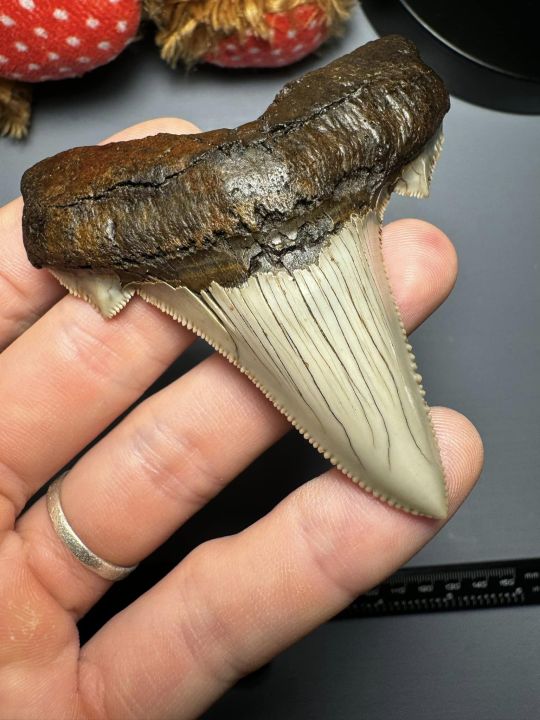
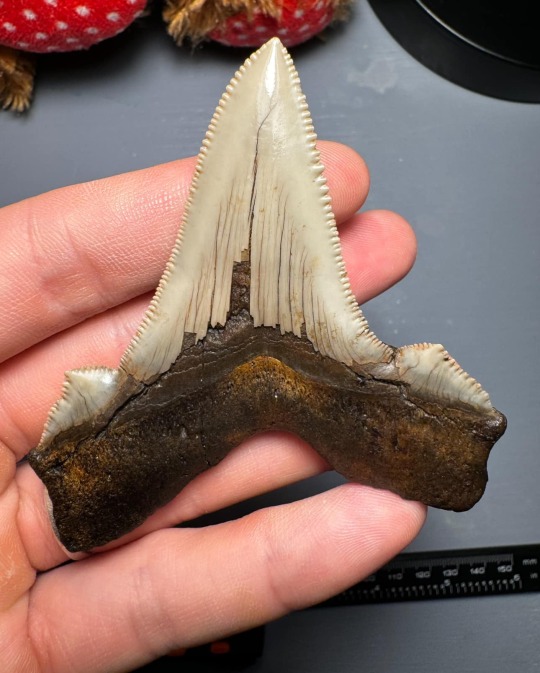
Carcharocles auriculatus
9 notes
·
View notes
Text
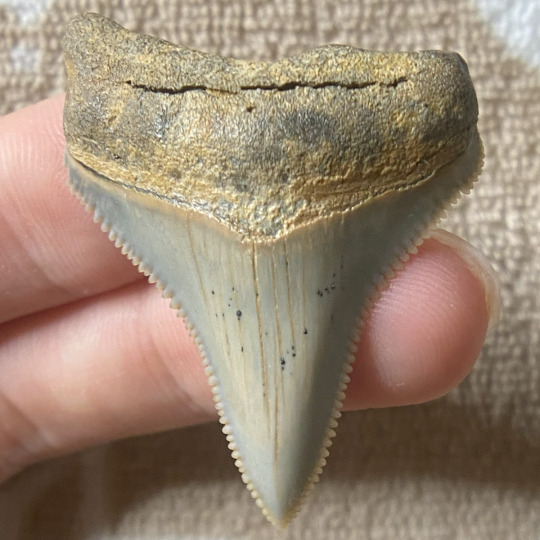
A fossilized shark tooth of an Otodus chubutensis from the Pyramid Hill Sand Member, Jewett Sand Formation in Pyramid Hill, Kern County, California, United States. This species is hypothesized to be the direct ancestor of the famous Otodus megalodon.
#fish#shark#chondrichthyan#fossils#paleontology#palaeontology#paleo#palaeo#otodus#carcharocles#oligocene#miocene#cenozoic#prehistoric#science#paleoblr#オトドゥス#カルカロクレス#オトドゥス科#サメ#化石#古生物学
6 notes
·
View notes
Text
Carcharocles megalodon (Tooth)

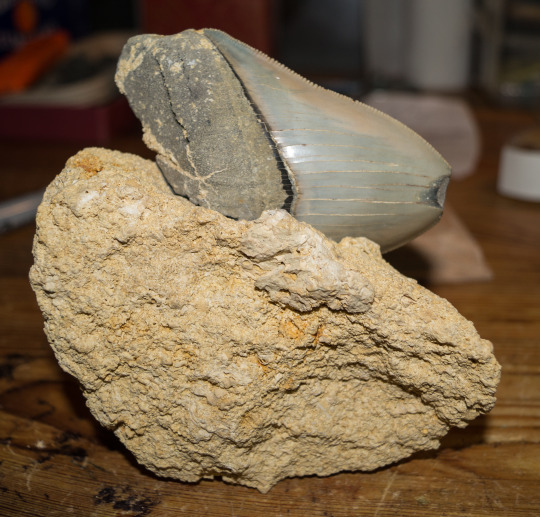
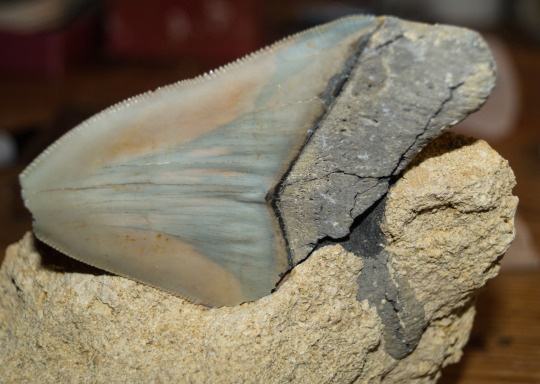
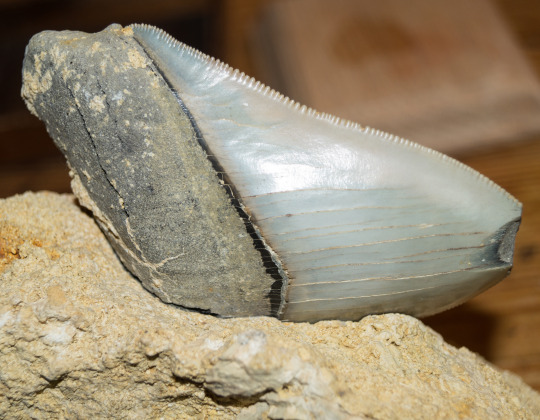
BB-F-0056
Location:
99mm / 675g
0 notes
Photo
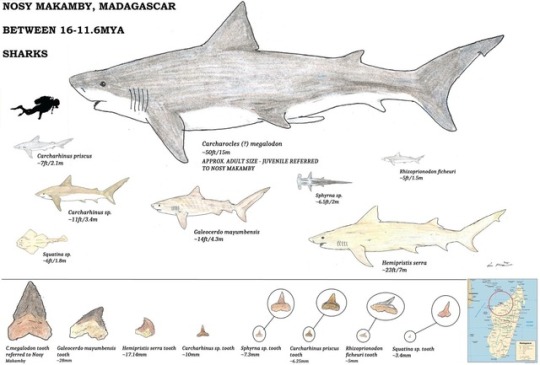
Decided to take a stab at restoring the sharks found at a site in Madagascar called Nosy Makamby. Several other shark genera are referred and there are rays, among other animals preserved here, but I focused only on the Miocene shark genera described in a 2015 paper by Andrianavolana et al. -Carcharocles megalodon: tried not to go for a carbon copy of a great white as most do, but when you scale up Cretolamna (the only completely known otodontid related to it), you essentially get that. However, the fins are based more off other giant sharks such as basking sharks. -Carcharhinus priscus: appearance based off of modern reef sharks which belong to the same genus. -Carcharhinus sp.: another member of the same genus though of a different genus, appearance based off of Galapagos sharks to which it was closely related. -Squatina sp.: an unknown species of angelshark, as angelshark teeth are extremely hard to differentiate. Obviously based off modern angelsharks. -Galeocerdo mayumbensis: modern tiger sharks are the only representatives of this genus, so this species is based off of them complete with patterning to help differentiate it here. Its teeth are similar in size to modern tiger sharks, so I put it at around the same size. -Sphyrna sp.: a species of hammerhead shark, I'm not certain if the size is accurate but the referred tooth is quite smaller than that of a great hammerhead which ranges from 11-20ft long. Obviously, since only a tooth is known, it is uncertain what head shape it would have had - I went with the "classic" hammerhead shape. -Hemipristis serra: a giant snaggletooth shark that is generally estimated at 23ft in length. Of course, based off snaggletooths in appearance. -Rhizoprionodon ficheuri: it is hard to find exact tooth sizes for the Rhizoprionodon genus, so this is based off a rough estimate of a picture of a sharpnose shark, which reach 4-5ft long. I'll probably come back to restore the rays and perhaps the other fauna of Nosy Makamby as well.
#megalodon#shark#sharks#carcharocles#carcharoclesmegalodon#carcharodon#carcharodonmegalodon#otodus#paleoart#paleo#paleoblr#paleontology#palaeontology#sharpnoseshark#milkshark#hammerhead#hammerheadshark#squatina#angelshark#milk shark#hammerhead shark#Madagascar#nosymakamby#prehistoric#prehistory#carcharhinus#carcharhinuspriscus#sphyrna#galeocerdo#tiger shark
18 notes
·
View notes
Photo

We bet these fascinating Megaladon Shark Teeth would be right up the alley of someone you know! Carcharocles are an extinct giant white shark species that lived approximately 23 to 3.6 million years ago. These ancient teeth were found in North Carolina. ($125 - 345 / each) #sharkteeth #megaladon #carcharocles #ancient #ancientshark #whiteshark #fossil #ancienttooth #decorate #gift #shark #marinebiology #curiosity #minerals #shop #nyc #unionsquare #beadsofparadise (at Beads of Paradise NYC) https://www.instagram.com/p/B7MvWBTB81M/?igshid=11ilxg66erdbx
#sharkteeth#megaladon#carcharocles#ancient#ancientshark#whiteshark#fossil#ancienttooth#decorate#gift#shark#marinebiology#curiosity#minerals#shop#nyc#unionsquare#beadsofparadise
0 notes
Text
Honestly the potential that Megalodon looked more like the Sand Tiger Shark it would be more terrifying, interesting and beautiful cause for me Great Whites only look scary when you take account of their size but Sand Tigers already look broodingly mysterious and unpredictable and when you add the size...
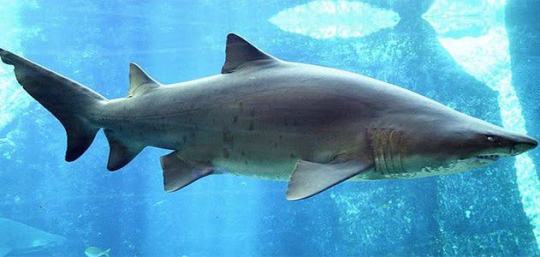

Anyway Sand Tiger Otodontidae Meg > Great White Lamnidae Meg
#sand tiger shark#shark#megalodon#carcharocles megalodon#great white shark#palaeontology#palaeoblr#science#biology#marine biology#fish#fossil
56 notes
·
View notes
